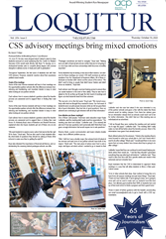“What is so interesting about [Dolly] is that they used a somatic cell instead of a germ cell. They can reprogram the DNA to start all over again,” Dr. Sheryl Fuller-Espie, professor of biology, said.
Cloning is based upon a somatic cell nuclear transfer technique. In this process, a somatic cell nucleus – a mature cell nucleus taken from an adult organ – is transferred into an egg cell whose nucleus has been removed. This fused cell grows into an embryo that is implanted into a “surrogate” mother’s womb. The difficulty in duplicating this process in humans arises from the specialization of the human cell. Many genes are “turned off” when the cell becomes specialized. Currently scientists are unable to turn these genes back “on.”
Somatic cells are the cells that make up the organs and all body parts; they are specialized cells. Somatic cells also are older and have replicated themselves many more times than germ cells or gametes. Gametes are the cells used in reproduction; sperm and egg cells.
“Somatic cells include blood cells, cells of the tissues and organs, neurons, and bone marrow stem cells, but do not include the sperm or ova which are referred to as germ cells or gametes,” Fuller-Espie explained.
At the tips of chromosomes are telomeres, which are basically protective covers for the valuable DNA on the inside of the chromosome. The telomeres in somatic cells degenerate with cell division, while the telomeres in gametes are repaired and maintained by an enzyme called telomerase. When the telomeres degenerate in somatic cells they get smaller and smaller until valuable strains of DNA are exposed and the cells dies.
“The telomeres are highly repetitive sequences – enough sequences for a normal life,” Fuller-Espie said.
In DNA replication, these telomeres get smaller and smaller, and over the course of a life the chromosome gets smaller. In humans, this cell division occurs about 70 times over an average life span. One risk in using these somatic cells for cloning is that the age of the cell is uncertain. When these telomeres are worn beyond repair the cells die. If the clone is made from an older cell, there may be less telomere to protect the DNA and as the clone grows it may be unable to produce vital proteins or develop defects based upon its genes, and its cell may begin to die prematurely. This process is known as senescence.


